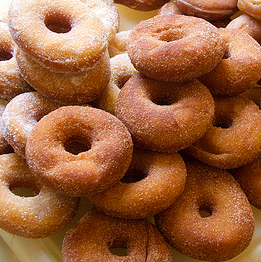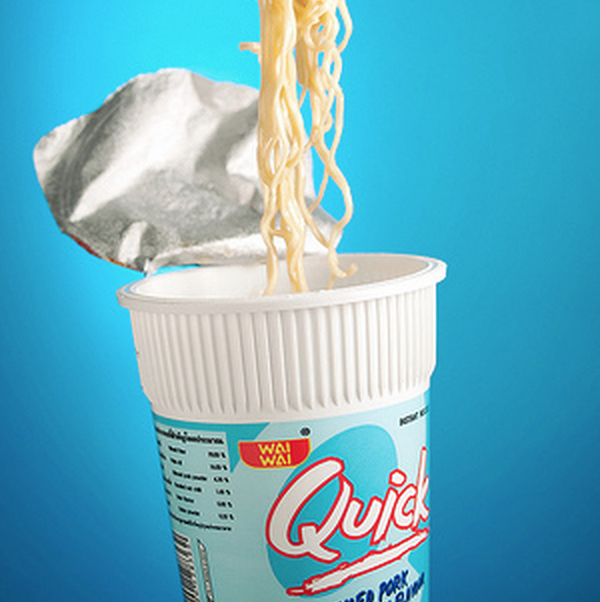The Donut Man of Seattle Speaks Out—With a Big Complaint About a Book I Wrote

Ever get a totally unexpected email? A blast from the past? This week I heard from someone about a passing encounter that took place eight years ago. Here’s the story!
***
First, some background.
In The $100 Startup, I told an anecdote of running my first marathon in Seattle back in 2006. Along the way, a funny thing happened: at mile 23, just as I was desperately hobbling along in hopes of reaching the finish line three miles later, a man on the side of the road stood offering donut holes to runners.
At the time I thought: “What a crazy idea!”
Don’t get me wrong: I love donuts. I eat donuts far more than I should. But toward the end of the longest distance I’d ever run, a donut was the last thing I wanted. Meanwhile, a few blocks later, another volunteer was handing out orange slices. That was perfect! I gladly took one, as did every other runner I saw.
As I wrote about it in the book, the story wasn’t really about donuts and orange slices. It was a parable: I was trying to illustrate the lesson of an offer you can’t refuse. A compelling offer is not only “awesome,” it also comes along at precisely the right time. In my world, the orange slice was the perfect offer that chilly day in Seattle—not the donut.
Since writing the book, I’ve told the story of the orange and the donut many times. It usually goes over well.
But Guess What? It Turns Out the Donut Man Is a Real Guy

You’ll never guess what happened, or maybe by now you will. While on the road this week, I heard from the donut man—as in, literally the same guy I happened to see at mile 23 of the marathon more than eight years ago. WTF!
Apparently a friend of his told him about the story in the book, and the donut man wanted to defend his name. Oh, and it also turns out he has a real name. When he’s not known as “donut man,” he also goes by David Peterman.
David wrote in with some criticism and a correction, both of which were too good not to share. I’ve included his note below, along with some commentary by me at the end.
***
The Donut Man Speaks Out In His Own Voice
Hi Chris,
I need to start this message with a huge disclaimer: the information that I’m responding to came to me second-hand. I have not read this passage in your book, so I’m just going by what someone else told me they read. We all know how stories can mutate as they are retold, so if I’m reacting to something that is incorrect, you can probably ignore most everything I’m about to write.
What was relayed to me is that there is a passage in your book that describes doughnuts being handed out at the Seattle Marathon and that this qualifies as a huge marketing fail. As the guy who has been handing out those doughnuts for the past several years, allow me to explain why this is… well, wrong.
I have been an avid runner since 1998 and have completed 18 marathons. One thing that I learned about myself early on was that as I neared the finish line, I started craving sweet things. I mean SERIOUSLY craving sweet things. I took to stashing giant cookies in my clothing pickup bag so that I could dig into one shortly after finishing the race.
A few years ago, the running group I am a member of began sponsoring the water stop at mile 23 of the Seattle Marathon. It wasn’t long before I started focusing on catering to those runners who share my intense craving for sticky sweet doughy goodness, and what better way to do this than to offer doughnuts! So every year since then I have been on the side of the road, a box of cut-up doughnuts in hand, and a pair of bright red devil horns on my head for extra effect. (At this point it should be noted that the doughnuts were always paid for by our running group; they were not donated by any doughnut retailer.)
So how did this go over? Absolutely spectacularly. Yes, there are many runners who see me and quickly move to the opposite side of the road to be nowhere near what I’m holding out. But then there are the hundreds of runners who come bounding up to me beaming from ear-to-ear as they zero in on their target. I’ve received countless high-fives and numerous marriage proposals, and repeat runners tell me they have been looking forward to seeing me for 23 grueling miles. This past year I started with an inventory of over 750 doughnut holes and there were none left over.
To recap, I determined a need based on my own experience, developed a means to satisfy this need for a larger audience, implemented the plan, and found it to be very successful. Not really what I would call a marketing fail. And besides, just look at this picture. That is nothing but win.

***
Wow! What a fun (and crazy) message. As I told David in my private response, I have absolutely no complaint about him. Among other things, he’s run 18 marathons. I’ve run only 4, and I have no plans for another right now. The other day I did a grueling 5k jog on the hotel treadmill… so yeah, I’ve got nothing there.
More importantly, as I mentioned earlier the story was really just a parable, not a criticism of the donut man himself. I had no idea this was a regular thing!
Lesson #1: Never assume no one will hear about a story you write or speak about, even one that’s told anonymously, many years later.
Lesson #2: The original principle of the story still holds: the right offer still has to come in the right place, at the right time.
Personally, I prefer to munch on my donut holes at the end of the race, not at mile 23. But what do I know? David has obviously found himself a very hungry market.
I want to emphasize this part of his email:
“I determined a need based on my own experience, developed a means to satisfy this need for a larger audience, implemented the plan, and found it to be very successful. Not really what I would call a marketing fail.”
It’s definitely not a fail—this is indeed the whole point of an offer you can’t refuse.
Three cheers for David, who’s probably tired of me calling him the Donut Man of Seattle.

Readers, feel free to update your copy of the book (p. 111 in the original U.S. hardcover edition). The principle is still correct, but I was wrong about this example. 🙂
###







